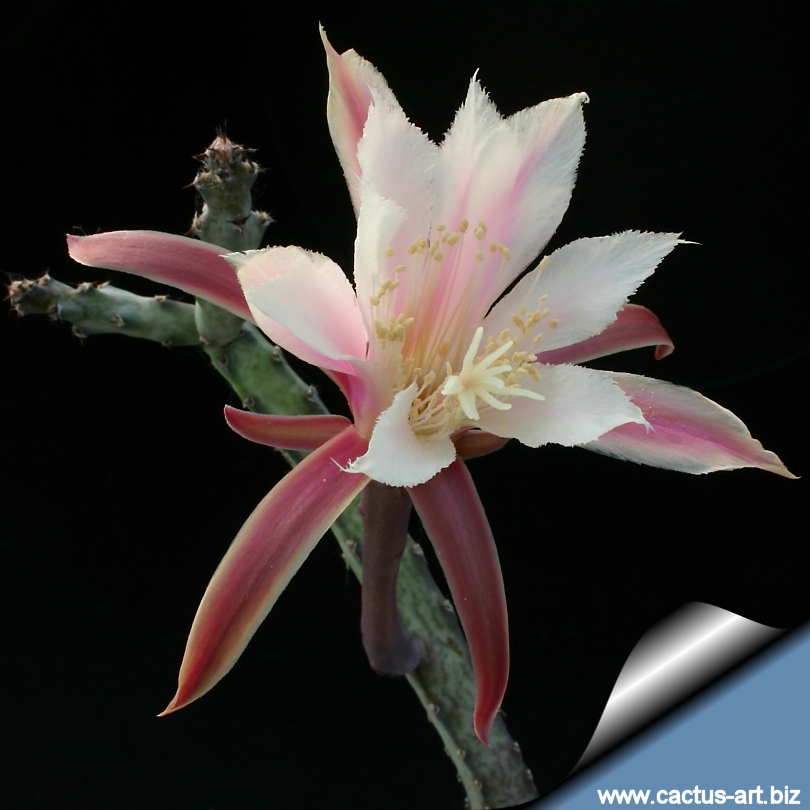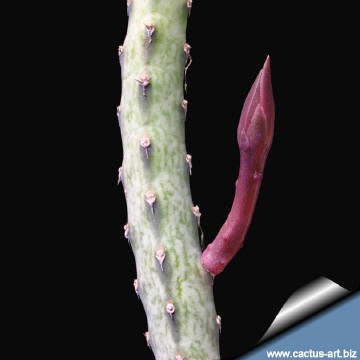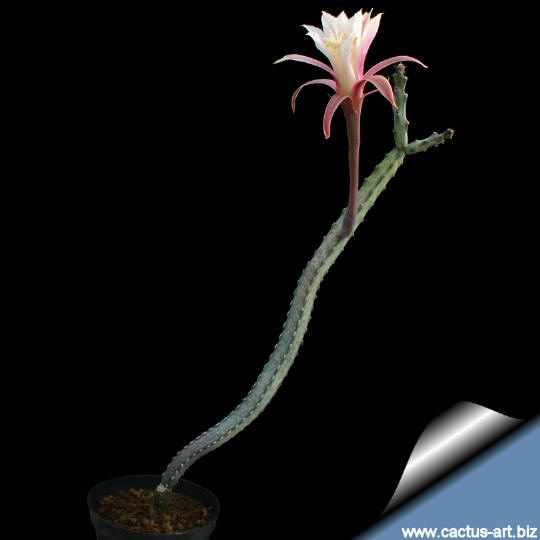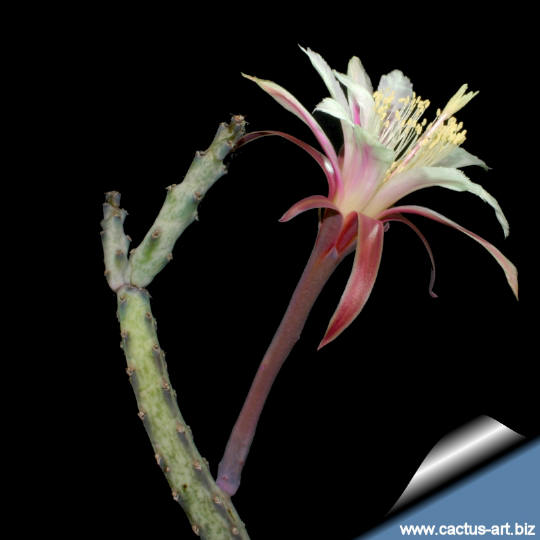|
|
|

Monvillea spegazzinii
(The moonlight plant)
Because of the beauty of flowers this cactus
has met with great favour. It is one of the most prolific
bloomers of all cacti, flowering from April to September. The flowers
open in the early evening.
Monvillea are also attractive because of their white purplish mottled or
marbled stems.
|
 |
Description: Monvillea spegazzinii is a slender shrubby cactus that has a similar
form and habitat to the night-blooming cereus (Peniocereus greggii). It
puts forth many basal shoots, soon becoming tillered.
Stems: Branched, bluish mottled in purple and green, erect or
semi prostrate , up to 1.8 m long or more, 2 cm inches in diameter;
Roots: Tuberose and succulent, Even adventitious roots of
Monvillea spegazzinii become succulent.
Ribs: Three to five (usually four) raised angular that have deep
incisions similar to indentations along the edge. They are about 3 cm
long at the base and bear small areoles at the apex of the
protuberances.
Central spines: One 1.5 cm long;
Radial spines: The Young plants usually have three sharp,
blackish spines 5 mm long, two pointing upward and one downward. On the
older parts there are five radial and one central spine, 1.5 cm. long.
|
Flowers: 10 to 13 cm in length with a slender tube, reddish outer
perianth segments and white inner ones. They arise from near the top on
the sides of the stems; buds point upward but curve suddenly downward
when the flowers open. They bloom at night.
Fruit: Smooth, red, juicy with persistent perianth remnant that
withers slowly and dries attached to the end of the fruit. Flowers.
Remarks: These plants frequently produce monstrose crests, and crests
occasionally produce normal shoots.
The crested variety have spectacular blue marbled stems with pronounced
sculpture effects
|
|
Cultivation: Produces best results in loose and very drained
soil, rich in leafmould, and if sufficient water is supplied in warm
weather a rather considerable growth can be made. It needs semi-shade.
The plants will stand but little cold and require
a minimum winter temperature of about 10° C. (but can resist for short
period to 0° C). Growth is rapid, and supports are needed for the stems.
The half‑erect habit of the moderately tall plants makes them
desirable for middle foreground position in landscaping, while the
comparatively small room needed for potted plants makes it an acceptable
group for greenhouse culture.
Propagation: (usually) by cuttings.
Cuttings will flower sooner than plants grown from seed, and are quite
plentiful.
Photo of conspecific taxa, varieties, forms and
cultivars of Monvillea spegazzinii.
|
|
Advertising
|
|
|
|
|
Family:
Cactaceae (Cactus
Family) |
|
Conservation status: Listed in
CITES appendix 2.
Scientific name:
Monvillea spegazzinii (Weber) Britton and
Rose
Tribe Cacteae Subtribe Cereinae
Origin: Paraguay and northeastern Argentina.
It was discovered near Resistencia, capital of the province
of Chaco, Argentina.
Habitat and
Ecology: Monvillea
spegazzinii has little capacity to swell or shrink during rainy/dry
cycles. It occurs in only moderately dry areas, growing among leafy
shrubs and small trees.
Common Name: Moonlight
cactus, Nightblooming cereus
Etymology:
The genus name Monvillea commemorates M. Monville,
a well known student and collector of cacti in the eighteenth and
mid-nineteenth century, and today there are 10 known species.
|
Synonyms:
- Cereus spegazzinii F.A.C.Weber
- Piptanthocereus spegazzinii,
- Monvillea lindenzweigiana,
- Piptanthocereus lindenzweigianus,
- Cereus lindenzweigianus,
- Monvillea vallegrandensis,
- Monvillea ebenacantha,
- Monvillea anisitsii,
- Cereus anisitsii,
- Cereus marmoratus
|
|
|
|

This genus differs from Cereus in its thinner,
half-erect stems, and smaller but more prolific flowers.
|
|
 |
|


|
|